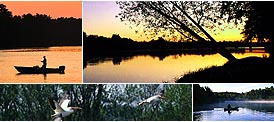

Alligator Hunting: A One of a Kind Experience -
Why They Call it Hunting Instead of Killing -
Florida's Other Crab - by Kris Thoemke
The Waiting Game - by Kris Thoemke
Mounted Memories - by Kris Thoemke
Eco-Touring in Collier County - by Kris Thoemke
Beyond the Largemouth Bass - by Kris Thoemke
Tying One On -- Some thoughts on how to get started tying your own flies -- by Kris Thoemke
The Big Cypress: Adventures in a Vast Wilderness
A Basic Guide to Saltwater Fly Fishing in Southwest Florida -- by Don Phillips
Four Strokes on the Water -- The sound of the future for marine outboards is likely to be much quieter --
Birding Big Cypress Swamp and the 10,000 Islands --
Recycling Your Fish -- by Kris Thoemke
Peace, Paddle and Hunt -- by Kris Thoemke
by Kris Thoemke
by Kris Thoemke
-- Kris Thoemke spends the day exploring the Big Cypress National Preserve with Preserve biologist Debra Jansen
by Kris Thoemke
by natural history writer and photographer Jeff Ripple
The alarm, set for 4:15 a.m. never had to ring. Eager with anticipation, or perhaps out of
consideration for my wife who didn't share my excitement of getting up in the early, early
morning, I awoke well before the alarm's sound waves ever had a chance to shatter the night's
silence. After a glass of juice and a muffin, the best breakfast available at that hour, I was on my
way to a day of exploring the Big Cypress National Preserve.
The day began with a swamp buggy ride with Preserve biologist Deborah Jansen. We headed in
a westerly direction from the Raccoon Point oil well fields. Our goal was to find, catch, and
band one or two red cockaded woodpeckers. To be successful, Deb told me, we had to have a
net over the woodpecker's hole before sunrise. The birds leave their night-time roost about
sunrise and don't return until sunset.
With the swamp buggy's headlights piercing through an early morning haze, we bounced along
an old swamp buggy trail that wound its way through a wet cypress slough to a patch of old
growth pines where the birds nested.
Sunrise was about a half hour away so there was plenty of time to get the net in place. Our early
start paid off; we netted the bird as it emerged for the day. The capture was part of a research
program to monitor the endangered species' status in the Preserve. Scientists, by studying the
movements of these birds, hope to learn the habits of the red cockaded woodpecker and help
expand the bird's habitat.
When she finished weighing the woodpecker and banding it, Deb let me release the bird. Over
the years, I've had the opportunity to handle a variety of wildlife. Moments like this are always
special. Slowly I opened my hand until the bird was free to fly off. It sat there for a few seconds,
ruffled its feathers and flew into a nearby pine. Once safely out of my grasp, the woodpecker
scolded us with a flurry of bird chatter.
With the sun well up in the sky, we emerged from the swamp, rendezvoused with the park's
helicopter, and lifted off. Only a few hundred feet in the air and with nothing but flat terrain
below, you can begin to appreciate the size of the Preserve. Grassy marshes and cypress strands
form a ribbon-like bands that run from horizon to horizon. Increasing altitude only reveals more
of the same.
Throughout the area, we also saw circular patches of tall cypress trees that dominated the
surrounding vegetation. At first glance they look like small round hills. Some have a dimple in
the center which, upon closer scrutiny, turns out to be a small pond.
These domes, as they are called, are really low spots in the landscape. Here water stands
year-round and the cypress tress grow taller than on the higher land surrounding them. A
difference of less than a foot in the Big Cypress translates into the difference between a pine
forest, marsh or a cypress dome. It is hard to convince your mind that the tall trees grow in the
lowest places.
Seeing so much of the spectacular beauty of the Big Cypress in one day is a sobering reminder of
how important it is to conserve this resource for future generations to appreciate.
Visiting the Big Cypress National Preserve
Most experience the Big Cypress National Preserve as they drive between the east and west
coasts on US 41 or Interstate 75. The view, seen through the windows of a car going 55 or 70
miles per hour, is impressive but you won't get the feel for the Big Cypress unless you stop.
Unfortunately, only a small percentage of those in-transent stop to see what the swamp has to
offer.
If you want to learn more, the best place to stop is at the Oasis Visitor's Center located about 25
miles east of the US 41 and State Road 29 intersection. There are some displays, a videotape
about the Preserve, and a small selection of books for sale.
From the visitor's center the more adventurous can hike a part of the Florida Trail. The hike,
except during the driest months, is a wet hike. Those that attempt it see a small piece of the
south Florida wilderness. Wet marshes and cypress sloughs stretch on as far as the eye can see.
There is a great sense of being isolated from civilization.
by Kris Thoemke












